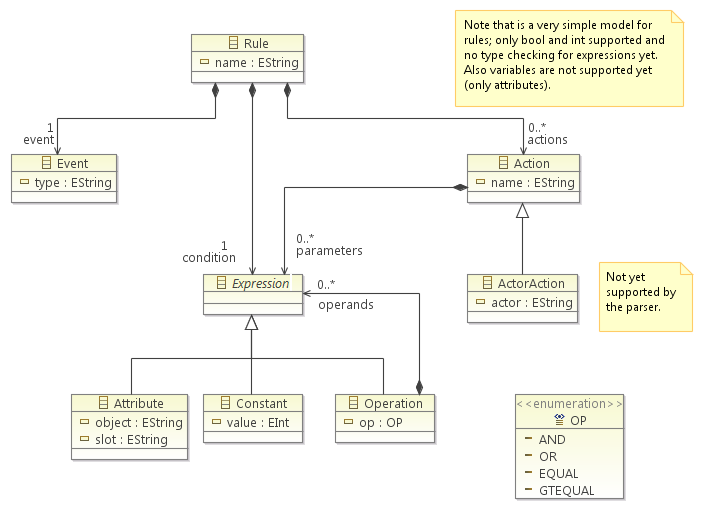The last tutorial of this course discusses some additional technologies that might be
needed for the project. Specifically, a technology for parsing some strings into
an abstact syntax tree (AST) is discussed. Such a parser will be needed for implementing
the language for the rules that handle the incoming events.
There exist many parser generators based on Java (see this comparison
for an overview). First and foremost, the difference is on the parsing methods and the
class of languages that is supported (e.g. LL(k), LALR(k), and LR(k)); but there are
also differences in usability, IDE support, and required additional technologies for running
the generated parsers.
Since the language for formulating the rules in our project is relatively simple,
we discuss the JavaCC parser and scanner generator
in this tutorial. JavaCC
does support LL(k) grammars only and does not have the smoothest IDE integration. But,
it easy to get started with and produces a relatively lightweight parser without any
additional dependencies; therefore, the generated parser can be easily deployed to different platforms
as long as a Java installation is available.
If you know other parser generator technolgies such as ANTLR,
you can user them for your project, too. In the previous years, we had used Xtext (see last year's assignment 6 for more
information), but since Xtext is tightly integrated with EMF
that we are not using in this year's project, it is not very suitable for our
purposes this year.
As an example, we generate a parser for a very simple rule language. Two examples of
rules in that simple language are shown below
test1:
when DoorAlarmEvent
if event.source == 1 // this should better be a String identfying the source
&&
event.value >= 50 // better user a float here
&&
system.securitylevel == 1
then actorSound1.play(1,30), // the sound to be palyed should better be a string
// the time it should be palyed could be a float
UserAlert.raise(event.event); // could be event only (my model and grammar
// does bot alow single variables
test2:
when DoorAlarmEvent
if system.securitylevel >= 2
||
event.source == 1 // this should better be a String identfying the source
&&
event.value >= 50 // better user a float here
then actorSound1.play(1,30), // the sound to be palyed should better be a string
// the time it should be palyed could be a float
UserAlert.raise(event.event); // could be event only (my model and grammar
// does bot alow single variables
The constructs of that language are defined by the following class diagram, which formalizes
the abstract syntax of this language (not that contraints are not covered here):

The definition of the concrete syntax of this language along with the definition of a parser
for that language can be found in the file Rules.jj.
This file and the underlying concepts of attribute
grammars will be explained and
discussed in the tutorial. Note that the file
Rules.jj refers to the Java classes of the abstract syntax
(UML diagram above); the code for these classes was automatically generated
and is contained in the complete project, which is availabe here: rulesparser.zip. But, this code won't compile in your version of Eclipse
unless you install EMF on your Eclipse; but you do not need to do that, you can write
the classes representing the abstract syntax manually.
For generating the parser from file Rules.jj, you need to either
install the JavaCC plugin for Eclipse or
you need to install JavaCC as standalone software (without any IDE) from here or here.
In the tutorial, it will be explained how the code for the parser can be generated for the
parser definition and how this code can be used.
For more details, have a look at the following tutorials:

